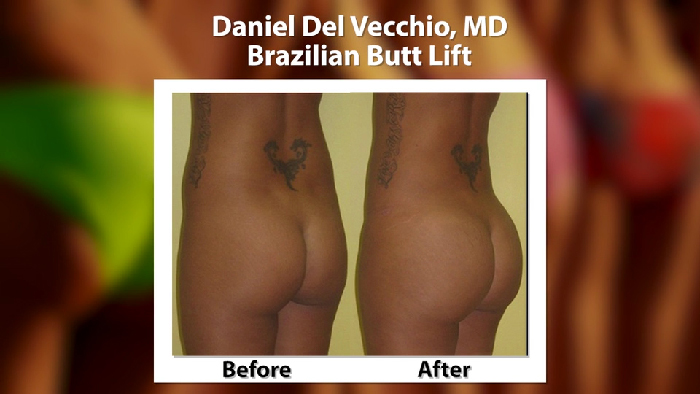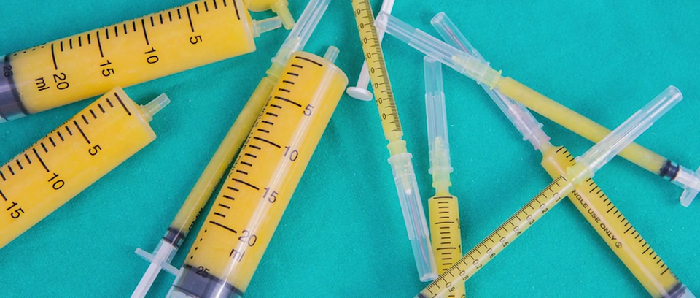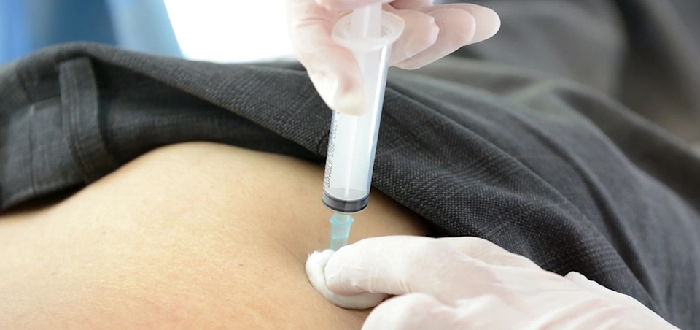Unlike a traditional butt augmentation, a Brazilian butt lift does not use an implant to improve the shape of a patient’s backside. During a Brazilian butt lift, a surgeon harvests fat from areas on the body where it is unwanted, and transfers it to the butt in order to improve contour and shape. While implants can improve the shape of a rear end, the removal and transfer of a patient’s own fat provides the additional benefit of improving two areas at one time.
In many cases, surgeons are able to transform a boxy waist and a flat buttock into the curvy hourglass figure that is pop culture’s gold standard. The Brazilian butt lift provides a three dimensional transformation, removing fat from the waist, hips and elsewhere and using that fat to reshape your rear end.
“Brazilian butt lift is a name given to the procedure by a Beverly Hills plastic surgeon. It has nothing to do with Brazil,” clarifies Dr. Dan Del Vecchio, a well-respected authority on buttock enhancement through fat transfer.
Risks & Complications Associated with the Brazilian Butt Lift
If you’re considering fat transfer to improve the appearance of your backside, there are risks you should be aware of. “The biggest risk is death on the table – and that’s due to injury to the deep veins around the muscle that go right back into the heart,” explains Dr. Del Vecchio. “When fat gets into that vein, it can block the heart. It’s a real problem, and it’s a bigger problem than we thought it was.”
The good news for patients interested in the Brazilian butt lift is that there are fat transfer techniques available to surgeons that can greatly reduce or potentially eliminate the danger of fat entering the veins.
Minimizing the Risks: Cannula Selection
In order to minimize the risk of damage to the veins in the buttock area during fat transfer, Dr. Del Vecchio recommends finding a surgeon who uses larger cannulas for the extraction and placement of fat. A cannula is a thin hollow tube inserted into the body to both extract and place the fat. Some cannulas have very sharp tips, and some are more blunt. “If you think about it, the smaller the needle, the easier it is to penetrate. It’s counter-intuitive, people think smaller is safer, but in this situation, bigger and blunter is safer.”
Consider for a moment a balloon full of air. If you lightly bump the head of a large baseball bat against the balloon, it is unlikely to pop it. However, if you apply the same pressure to a very sharp thumbtack against the same balloon, you are much more likely to pop it. The balloon in the illustration is similar to the deep veins in your buttock that need to remain in tact. The baseball bat would be similar to a large, blunt cannula used to harvest fat. A small, sharp cannula would be more like the small, sharp thumb tack.
Not only are the larger cannulas safer in Dr. Del Vecchio’s opinion, but they are also more efficient – cutting down on the time the procedure requires a patient to remain under anesthesia. “We do this operation in about an hour and a half to an hour and fifteen minutes, depending on the size of the patient,” says Del Vecchio.
Minimizing the Risks: Avoiding Syringes
Another technique that may improve the overall safety of the Brazilian butt lift procedure is the use of a pump instead of a syringe. “Syringes make your hand fatigue,” explains Del Vecchio. “If you’re trying to insert something in and initiate flow with the same upper extremity, it’s fatiguing. If you use a pump to initiate the flow of fat, you’ve taken that fatigue off the table. Now the surgeon can focus on the placement of fat, and avoid the deep veins.”
Questions to Ask a Surgeon Before Scheduling a Brazilian Butt Lift
- Have you had any deaths with the Brazilian butt lift procedure?
- How many have you done?
- How often do you do the procedure each month?
- What technique will you use?
- How long will the procedure take in the operating room?
- Can I see your pre- and post-operative result photos?
When it comes to selecting a surgeon, Dr. Del Vecchio urges everyone to find a surgeon who completes Brazilian butt lift procedures often. If the surgeon expects the procedure to take several hours or more, it can also be a red flag for the patient. A long procedure may indicate that the surgeon is using a syringe to extract the fat, or perhaps they are using very small cannulas, which would also increase the amount of time the procedure would take.
Being aware of the benefits and risks involved is important with any plastic surgery procedure. When you choose a board certified plastic surgeon who specializes in Brazilian butt lift procedures, you can rest assured that your surgeon has the proper training, proper experience, and that your safety is their top priority.


















Facebook
Twitter
Instagram
YouTube
RSS